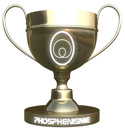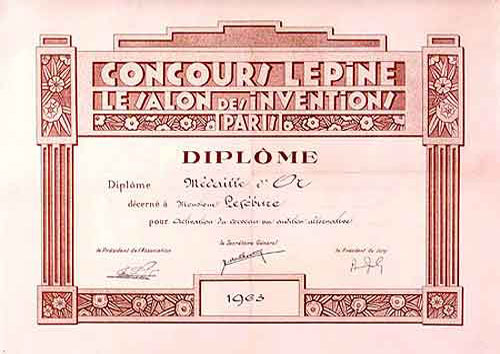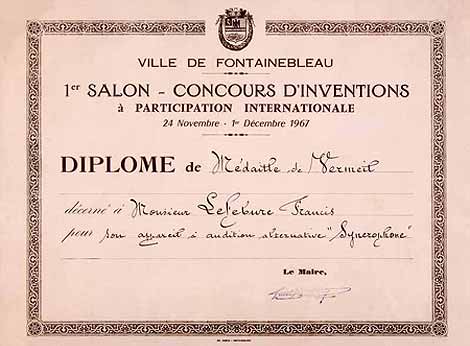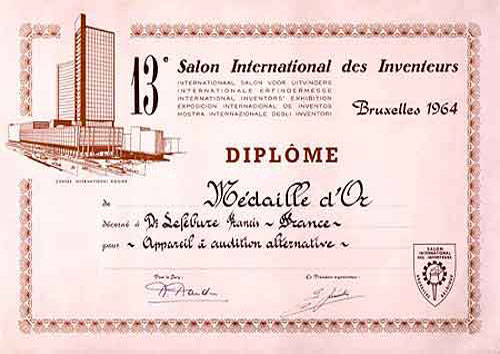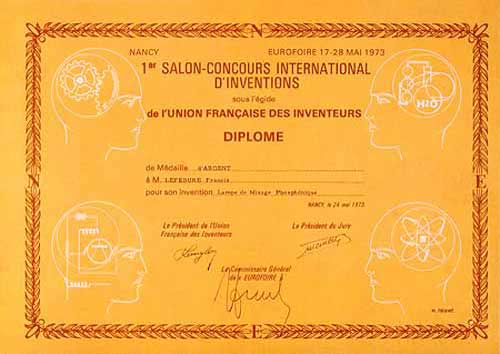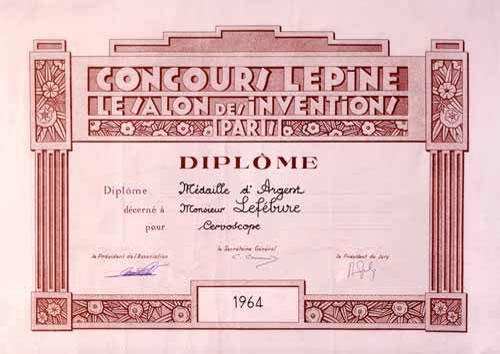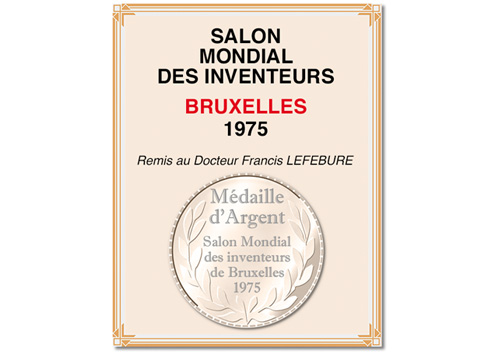THE FOUNDER
Doctor Francis LEFEBUREHis life and work.
- Former Extern of the Paris Hospitals.
- Former Physician at the French School Health Services.
- Former Teacher of Sciences and Mathematics in the French Public Instruction.
- Gold Medal and 1st Prize at the French ‟Lépine” Contest, in 1963, for his device: the Alternophone.
- Gold Medal at the International Inventors’ Fair of Brussels, in 1964.
- Silver Medal at the French ‟Lépine” Contest, in 1964.
- Vermilion Medal at the 1st Invention Fair-Contest, in 1967.
- Silver Medal at the 1st International Invention Fair-Contest, in 1973.
- Silver Medal at the World Inventors’ Fair of Brussels, in 1975, for his method: ‟Phosphenic Mixing applied to Education”.
His father, a lawyer, ran a magazine treating thermal and touristic law. He attended the Lycée Louis Le Grand, the high school (or secondary school) which produced the greatest number of famous French men. All his life, Dr. LEFEBURE kept a fond memory of his Science teachers. At the age of 17, he attended the ‟P.C.N.” (Physics, Chemistry, and Natural Sciences), which served as a preparatory year before the study of Medicine.
He graduated among the first of several hundred students, even though he was the youngest. At the age of 13, simultaneous to his academic studies, he started to express an interest in methods of personal development, in yoga and spiritual sciences. This was mainly because D. LEFEBURE lived in the famous ‟Latin Quarter” of Paris which, at the time, was the only place where bookshops specialized in that domain could be found.
That early research was greatly facilitated by his mother, who, knowing his interest in these subjects, would search out and collect all the best books for him.
At the early age of 15, he had already passionately studied all the works of the philosopher and founder of anthroposophy, Rudolph Steiner.
Much later, after his discoveries relating to phosphenes, D. LEFEBURE completely pulled away from Steiner’s work.
At the age of 18, he began to study medicine. His main interests resided in anatomy, histology, physiology, and physics applied to medicine, a subject in which he obtained the highest marks but, like Darwin, he never had any interest in pathology or clinical medicine, though he did study those subjects to succeed in his exams.
He became an extern of the Hospitals of Paris, choosing the neurology and child psychiatry departments. In June 1934, he met the person who in a certain manner became his mentor: Artheme Galip, an Ukrainian diplomat, son of the last governor of Bukovina, before it was annexed by the U.S.S.R. After the annexation, Galip moved to France as a refugee.
He had previously spent time in a Zoroastrian temple. This mentor could trigger visions by the laying on of hands but had not received proper instruction. There was a contradiction between his gift and the exercises he taught, some of them being actually harmful, others being just a waste of time.
Galip left for South America and disappeared. Dr. LEFEBURE, while continuing his medical studies, was left by himself to try and untangle the contradictory effects of the laying on of hands and the exercises Galip had taught him.
For that purpose, he passed his doctorate in 1942 in Algiers with a thesis on the breathing exercises of Yoga: Rhythmic breathing and mental concentration.
He was drafted in 1939 as an auxiliary medical officer and was later promoted to the rank of lieutenant medical officer.
The result of his meditations in the Army was a book: Homologies, the Analogies of the Microcosm and Macrocosm, which he considered to be his best work on an intellectual level. It is basically an extension of the theory of symmetry, the same path that academic science would take, more than 40 years later, with the study of ‟Fractals” and ‟Internal Homothecy”.
After leaving the Army, Dr. LEFEBURE decided to follow his lifetime vocation and started a degree in Biology, then taught science. But, being married, he had to accept a position as a school hygienic doctor.
He nevertheless continued his research and created the association ‛Homosophy’ (the Wisdom of Similarities), thus creating the first groups for the study of initiatic techniques, in 1945. While bringing up his three children, he spent his spare time writing another book, ‟The Power of Christianism” to prove that Christianism was built on exercises that were later withdrawn and to demonstrate that non-violence is the best means of defense.
It was at this time that he wrote about the effects triggered by Galip’s laying on of hands, in his book « Initiatory Experiences », and the out-of-body experiences that his method (published in Homologies) had produced.
his meeting with the Indonesian magus Pak Subuh was decisive, as Dr. LEFEBURE wanted to compare Subuh’s exercises to those of his first mentor.
Electroencephalograms were impossible to use as they require muscular relaxation, so he came up with the idea of monitoring the action of different variants of a given exercise on a phosphene.
This is how he discovered the first phosphenic phenomenon that had never been documented before: if the head moves at a rhythm of two seconds, the phosphene follows that movement. If the movement of the head is faster or slower, the phosphene stays fixed.
Dr. LEFEBURE receiving the Gold Medal at the
1st Invention Fair-Contest of Fontainebleau, in 1967.
That led him to experiment on what would happen with two phosphenes.
The method of brain exploration through the study of the rhythms of double phosphenes proved to be of extraordinary richness and practical use. He wrote a book on that subject. Its first draft was a report that he transmitted to the School Health Services in the spring of 1960.
That book describes various rhythmic and cerebral phenomena previously unknown and which became possible to observe thanks to the Cerebroscope, a device for which Dr.LEFEBURE was awarded the Silver Medal at the French « Lépine » Contest of the Inventions Fair, in 1964.
He then applied that discovery to the ear and designed the Synchrophone which later became the Alternophone, a cerebral activation device, and subsequently wrote: ‟Activating the Brain with Alternating Hearing”.
He was awarded the Gold Medal and the first prize at the French « Lépine » Contest of the Inventions Fair, in 1963, and the Gold Medal at the International Inventors’ Fair of Brussels, in 1964, for the action of the alternating hearing device on the brain: the Alternophone.
Dr. LEFEBURE practicing a cerebroscopic examination.
In 1963, he had the idea of studying what happens when an individual thinks about a particular subject during the presence of the phosphene.
That experiment was the origin of the principle of ‟Phosphenic Mixing”, a method that efficiently develops memory, intelligence, sense of initiative, artistic intuition, and creativity by mixing thoughts and phosphenes.
In November 1975, the World Inventors’ Fair of Brussels awarded Dr. LEFEBURE the Silver Medal for his method: ‟Phosphenic Mixing applied to Education” which had been reprinted for the 16th time, in 2004, and sold more than 58,000 copies.
The Synchroscope.
From that point on, he spent all his energy on perfecting that technique, teaching it, and applying it to the other sensory organs.
Each reader who reported the results obtained from the application of the method became an associate (their names have always been cited alongside what they had discovered unless Dr. LEFEBURE was asked not to do so). Thus, in twenty-nine years of work, he was able to amass a considerable amount of documentation that was unique.
The collected information underscored the role that Phosphenism had always played in the origin of religions and led to the publication of a book: « Phosphenism and the Origin of Religions » (also entitled ‟Developing Clairvoyance by using Phosphenism”).
It is during that period that he solved the great enigma of his youth: where did Galip’s strange power of laying on of hands come from? Indeed, phosphenes proved to be very easily transmissible by telepathy. The Zoroastrian regions were the only places in the pre-industrial world where oil naturally sprang from the ground.
Thus, from the dawn of prehistory, a line of the human race had much greater material ease for producing bright and permanent fires. Without being aware of it, they practiced Phosphenism but did not analyze the details of the process: thinking while focusing on a bright fire.
That is why, in these regions, there are individuals who are believed to possess a secret knowledge, while they simply have particular gifts resulting from an instinctive practice of Phosphenic Mixing.
That force has accumulated in certain lines of descent over hundreds of thousands of years.
Later, the extension of the principles of Phosphenic Mixing to breathing led him to write « The Pneumophene, or the breathing techniques that open the doors to the world beyond ».
A similar extension to the sense of movement led the doctor to write « From the Praying Wheel to the Spiritual Dynamo, or the Kundalini-triggering device ».
Dr. LEFEBURE considered that ‟thanks to the phosphene and the various types of Gyrascopes, a door has been opened in ‛esotericism’. The phenomena qualified as initiatic are finally accessible to everyone. The released force will surge through humanity like burning lava.” Then meeting Daniel Stiennon was a deciding factor for the diffusion of Phosphenism.
Indeed, this latter created quickly an association and, shortly after, a company that is now present all over the world.
The works of Dr. LEFEBURE can be compared to the works of the greatest scientists. After thirty years of organizing lectures and seminars all over the world, and several of the books having been translated into various languages, it can be said that Dr. LEFEBURE influenced researchers since 1945.
By the way, the famous Mrs. Alexandra David-Neel has never hidden that she studied the book that is the cornerstone of Phosphenism (« Homologies) and knew Dr. LEFEBURE.
Of course, many drew influence from his works without ever quoting him. On the contrary, Dr. LEFEBURE always quoted his sources.
Of course, such a summary cannot describe a lifetime of research, encounters, disappointments, joys, and ups and downs. Dr. LEFEBURE was above all a genuine research scientist, an extraordinary man, an innovator, whose totally original body of work will be the basis of many other discoveries about the mind, as he has solidly bridged the gap between cerebral physiology and initiatic techniques. He is the author of thirty books, a score of them about Phosphenism and its applications, and has invented five cerebral activation devices.
The main discovery that should be remembered in Dr. LEFEBURE’s body of work is the method of Phosphenic Mixing: a method that will greatly influence the evolution of humanity and which was the subject and the aim of a studies’ life: the scientific explanation of the religions’ origin.
(actual size of the diplomas: 19,7in x 23,6in)
Gold Medal and Prize at the French « Lépine » Contest, in 1963, for the action on the brain of the alternating hearing device: the Alternophone.
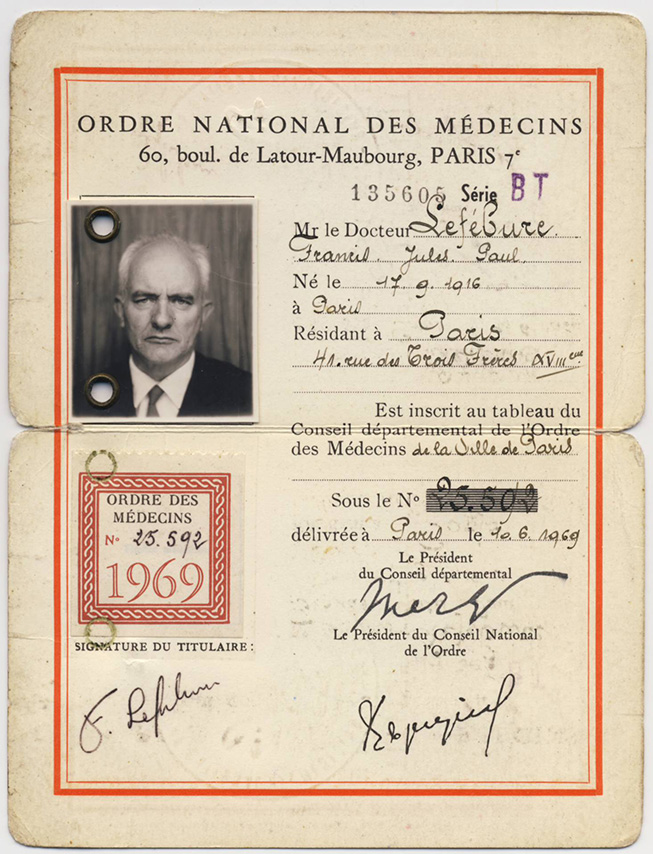
Gold Medal at the 13th International Inventors’ Fair of Brussels, in 1964, for the action on the brain of the alternating hearing device: the Alternophone.
Dr. LEFEBURE began as a school physician and then practiced as a general practitioner until his retirement.
He created the association ‟Homosophy – Wisdom of Similarities”, which shortly afterward became the association ‟Phosphenism”.
The first discovery of Dr. LEFEBURE regarding phosphenes, and the release of his first book on Phosphenism.
Verification of the discoveries from Dr. LEFEBURE by the C.N.R.S. (French National Center for Scientific Research), at the National Institute of Sports Laboratory, and at the Henri Roussel Hospital, both in Paris.
Following these revelations that ‟disturbed” the pope, the Catholic Church gave up recognizing ‟solar prodigies” as specifically catholic miracles, which is an implicit acknowledgment of the Dr. LEFEBURE’s discoveries.
**The first photographs of phosphenes were realized by Louis Cuttica (over a hundred of such photographs were taken).
The secret services of several countries, including France, took an interest in Dr. LEFEBURE’s discoveries. The religious implication of his work, however, proved to be beyond them and they closed the matter quickly.
Series of conferences in Germany, England, Portugal, the Island of Réunion, Quebec (Canada), and in parts of Africa.
*The first meeting of Daniel Stiennon and Dr. LEFEBURE.
**After discovering the rotational function of the brain, Dr. LEFEBURE created the Gyrascope.
**Launch of the first French training courses via video conference.

